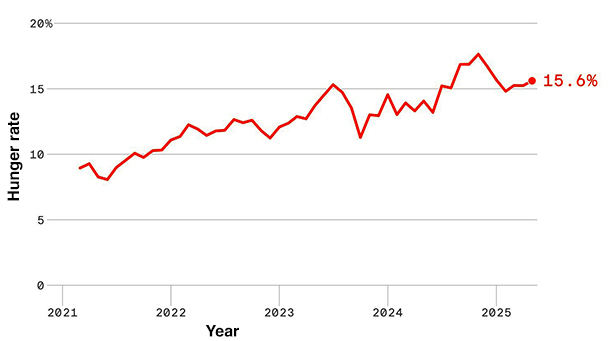

Morning Consult has been running an interesting poll for the past 5 years. Rather than asking: "Which party do you want to win the House next time" or something like that, it has been asking: "Do you often or sometimes have insufficient food to eat?" Here are the results:

As you can see, the percentage of people who often have insufficient food is now at 15.6%, up more than 50% since 2021. This has been a long-term trend and will soon get much worse, as millions of people will lose their SNAP (food stamp) benefits. That one out of seven Americans often goes to bed hungry in the richest country in history, while other people hold $50 million weddings is, well, shameful. John Leer, chief economist at Morning Consult said: "There's such a disconnect now between record highs on Wall Street and elevated levels of food insecurity."
During the past few years, one of the causes of food insecurity has been higher grocery prices, driven by pandemic-induced inflation as a result of disrupted supply chains. In the coming years, the rate is sure to climb, due to the BBB. For example, until last Friday, adults over 54 were not required to work to get SNAP benefits. Now the age cutoff is 64. Also, fewer parents will be exempt from working, even if their childcare costs exceed the amount of their take-home pay. Due to these and other restrictions, many people will get less food and, most likely, less healthy food as well.
Some hungry people may turn to food banks to feed their families. However, the food banks say they are wholly unprepared for millions of new customers. Many are turning to state governments and private donors to make up the expected shortfall. But states are strapped and private donors tend not to think buying cornflakes is a sexy way to spend money.
According to Feeding America, the cuts to SNAP will eliminate 6-9 billion meals annually. This is equal to the total that all food banks in America provide each year. In other words, to make up for the SNAP cuts, food banks would need to give out twice as much food as they do now. Food bank leaders say this is completely unrealistic. They can't do it.
And there is more. Many grocery stores in low-income rural areas serve large numbers of customers who pay with SNAP benefits. If the customers buy less due to smaller benefits, the stores may not be able to survive, since the grocery business operates on extremely small margins. Some stores may fail, creating food deserts. So people in rural areas, also known as Trump voters, may discover in 2027 that the only grocery store in their county has closed along with the only hospital. But we doubt they will connect the dots. (V)